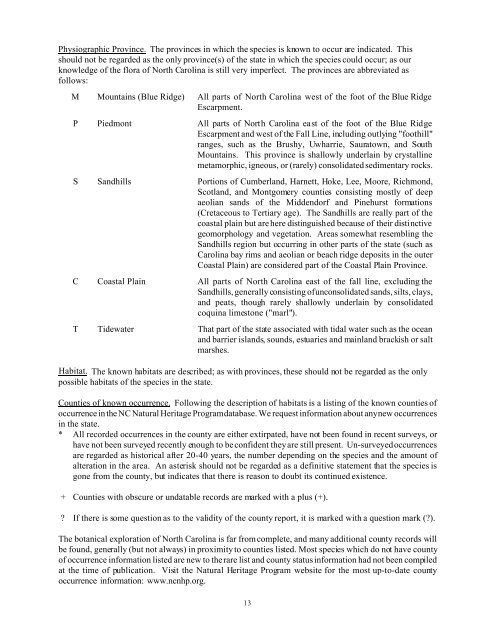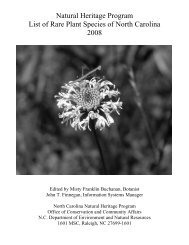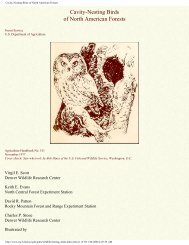Natural Heritage Program List of Rare Plant Species - Rawlings ...
Natural Heritage Program List of Rare Plant Species - Rawlings ...
Natural Heritage Program List of Rare Plant Species - Rawlings ...
Create successful ePaper yourself
Turn your PDF publications into a flip-book with our unique Google optimized e-Paper software.
Physiographic Province. The provinces in which the species is known to occur are indicated. This<br />
should not be regarded as the only province(s) <strong>of</strong> the state in which the species could occur; as our<br />
knowledge <strong>of</strong> the flora <strong>of</strong> North Carolina is still very imperfect. The provinces are abbreviated as<br />
follows:<br />
M Mountains (Blue Ridge) All parts <strong>of</strong> North Carolina west <strong>of</strong> the foot <strong>of</strong> the Blue Ridge<br />
Escarpment.<br />
P Piedmont All parts <strong>of</strong> North Carolina east <strong>of</strong> the foot <strong>of</strong> the Blue Ridge<br />
Escarpment and west <strong>of</strong> the Fall Line, including outlying "foothill"<br />
ranges, such as the Brushy, Uwharrie, Sauratown, and South<br />
Mountains. This province is shallowly underlain by crystalline<br />
metamorphic, igneous, or (rarely) consolidated sedimentary rocks.<br />
S Sandhills Portions <strong>of</strong> Cumberland, Harnett, Hoke, Lee, Moore, Richmond,<br />
Scotland, and Montgomery counties consisting mostly <strong>of</strong> deep<br />
aeolian sands <strong>of</strong> the Middendorf and Pinehurst formations<br />
(Cretaceous to Tertiary age). The Sandhills are really part <strong>of</strong> the<br />
coastal plain but are here distinguished because <strong>of</strong> their distinctive<br />
geomorphology and vegetation. Areas somewhat resembling the<br />
Sandhills region but occurring in other parts <strong>of</strong> the state (such as<br />
Carolina bay rims and aeolian or beach ridge deposits in the outer<br />
Coastal Plain) are considered part <strong>of</strong> the Coastal Plain Province.<br />
C Coastal Plain All parts <strong>of</strong> North Carolina east <strong>of</strong> the fall line, excluding the<br />
Sandhills, generally consisting <strong>of</strong> unconsolidated sands, silts, clays,<br />
and peats, though rarely shallowly underlain by consolidated<br />
coquina limestone ("marl").<br />
T Tidewater That part <strong>of</strong> the state associated with tidal water such as the ocean<br />
and barrier islands, sounds, estuaries and mainland brackish or salt<br />
marshes.<br />
Habitat. The known habitats are described; as with provinces, these should not be regarded as the only<br />
possible habitats <strong>of</strong> the species in the state.<br />
Counties <strong>of</strong> known occurrence. Following the description <strong>of</strong> habitats is a listing <strong>of</strong> the known counties <strong>of</strong><br />
occurrence in the NC <strong>Natural</strong> <strong>Heritage</strong> <strong>Program</strong> database. We request information about any new occurrences<br />
in the state.<br />
* All recorded occurrences in the county are either extirpated, have not been found in recent surveys, or<br />
have not been surveyed recently enough to be confident they are still present. Un-surveyed occurrences<br />
are regarded as historical after 20-40 years, the number depending on the species and the amount <strong>of</strong><br />
alteration in the area. An asterisk should not be regarded as a definitive statement that the species is<br />
gone from the county, but indicates that there is reason to doubt its continued existence.<br />
+ Counties with obscure or undatable records are marked with a plus (+).<br />
? If there is some question as to the validity <strong>of</strong> the county report, it is marked with a question mark (?).<br />
The botanical exploration <strong>of</strong> North Carolina is far from complete, and many additional county records will<br />
be found, generally (but not always) in proximity to counties listed. Most species which do not have county<br />
<strong>of</strong> occurrence information listed are new to the rare list and county status information had not been compiled<br />
at the time <strong>of</strong> publication. Visit the <strong>Natural</strong> <strong>Heritage</strong> <strong>Program</strong> website for the most up-to-date county<br />
occurrence information: www.ncnhp.org.<br />
13




